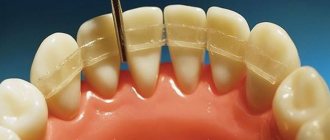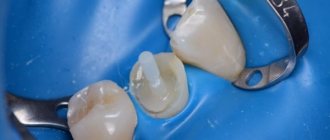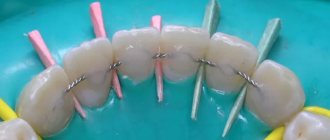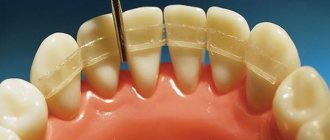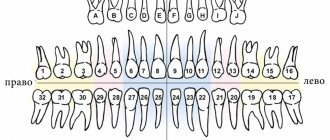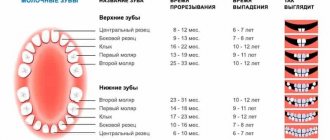One of the signs of moderate and severe periodontitis is tooth mobility caused by atrophy of part of the bone tissue of the tooth root. In order to prevent further loosening and loss of teeth, restore their appearance and chewing function, the CELT Dentistry Department uses fiberglass teeth splinting.
This technology is rightfully considered effective and gentle and is a worthy alternative to solid and ligature tires. And numerous positive reviews from patients who have undergone the procedure of splinting teeth with fiberglass in our clinic speak for themselves.
Splinting mobile teeth with fiberglass
allows you to fix the teeth in the optimal position and achieve an even distribution of the load between them. The procedure allows you to reduce the occlusal load, eliminating the risk of damage to the retaining bone and periodontal ligament. Thanks to it, you can avoid even greater loosening and displacement of mobile teeth.
Splinting of 1 tooth using Glass Span threads without composite - RUB 2,000.
Splinting of 1 tooth with light-curing composites—RUB 3,000.
At CELT you can get advice from a dental specialist.
- The cost of a consultation with a dentist-therapist is 1,000
Make an appointment
Indications
- Periodontal disease;
- Pathological conditions of the gums, in which they become inflamed and bleed;
- Oral injuries;
- Severe displacement of the dentition;
- Severely exposed tooth roots.
Contraindications
- Allergic reaction to materials or anesthesia;
- Pregnancy and lactation;
- Neoplasms of a malignant nature;
- Pathologies of bone tissue;
- Inflammation of the oral cavity;
- Poor quality of oral hygiene procedures.
Fiberglass splinting technique
Fiberglass threads have been used in dentistry relatively recently. The prices for splinting teeth with fiberglass are affordable, and the effect of the procedure has earned high marks from both doctors and their patients.
The procedure is carried out in several stages by an experienced specialist and includes the following:
- In order to prepare teeth for installation of a splint, they are cleaned of deposits, abrasive surface treatment is carried out, during which a horizontal recess is created for laying fiberglass tape, and the surface of the teeth is etched;
- Laying the tape into the recess is carried out gradually, inserting it into the spaces between the teeth;
- A light composite is applied and polymerized;
- The surface is sanded.
Scope of application
In dental practice, GlasSpan is used for the following purposes:
- periodontal splinting of teeth;
- if quick dental palliation is required;
- bring reimplanted and diseased teeth back to normal;
- strengthen bridges for a while;
- post-orthodontic preservation is necessary;
- carrying out splinting of anterior and lateral teeth;
- formation of long-term and short-term connecting bridges;
- quick replacement of lost or extracted teeth;
- adhesive splinting against the background of periodontal diseases;
- microprosthetics;
- restoration of teeth using an intracanal pin.
Features of splinting the anterior teeth of the lower jaw
The procedure requires creating horizontal indentations on the inner surface of the teeth. It is desirable that its height and depth be about 2 mm. A tape is placed in it and a light-curing composite material is applied. The number of teeth involved may vary and is determined depending on the condition of the front teeth. In addition to the most mobile ones, fixed teeth are necessarily involved: most often these are fangs. This approach allows you to remove the load from the movable incisors by transferring some of it to the canines.
Indications
Splinting structures are used for periodontitis or periodontal disease. Indications for splinting are:
- dentition disorders with tooth displacement,
- non-standard arrangement of some units in the dentition,
- deep periodontal pockets,
- bleeding gums,
- exposure of tooth roots.
Splinting structures can be prescribed to patients after wearing braces so that the corrected dentition does not return to its original position. This method is also used for fractures or dislocations of the jaw bone. The splint fixes the jaw and promotes proper fusion. The design and methods of fastening the splint for a fracture will depend on the clinical situation.
How is the effect achieved?
Looking at the photo of splinting teeth with fiberglass, you can see that the group involved in the splint is one whole and absolutely motionless... and this effect is not deceptive. The fact is that when illuminated, the fiberglass tape becomes very hard, and its fixation on the teeth makes it possible to redistribute the chewing load between the teeth. Even if the patient bites on one tooth, the load will be distributed over all teeth that are involved in the splint. This approach eliminates the loss of contact between teeth, which is observed with periodontitis. With it, each tooth receives maximum load, which leads to even faster progression of the disease. Thanks to the use of fiberglass tape, the process of bone atrophy slows down and often stops completely.
It is possible to save mobile teeth that are subject to extraction!
Long-term gum diseases (periodontitis, periodontal disease) lead to severe tooth mobility. Such teeth cannot fully chew food; biting on them causes a painful reaction.
It has become possible not only to slow down the process of destruction of dental ligaments (calculus removal, curettage of periodontal pockets, professional hygiene), but also to stabilize mobile teeth.
A splinting thread binds a group of teeth into a single whole, thus eliminating the mobility of an individual tooth.
If a load occurs on any tooth, it is distributed to the roots of the remaining teeth united by the splint. As a result, they become more stable, and periodontitis in this area ceases its destructive effect.
This type of teeth splinting is permanent and will support them for many years. Moreover, if for some reason you have to remove the splinting thread, the teeth can then be easily filled.
The teeth themselves will be more stable, since the chewing load is evenly distributed between them. The condition of the periodontium in the area of splinting is normalized.
The technique for splinting mobile teeth is shown in the figure below.
First, the doctor evaluates the mobility of the teeth and determines the type and thickness of the fiberglass thread. High-quality anesthesia is provided to ensure that the procedure is comfortable and completely painless for the patient. Then the splinted teeth are thoroughly cleaned of hard and soft deposits. The surfaces of the teeth with which the splint will come into contact are roughened with a special bur and etched with acid to obtain a larger contact area. To stabilize highly mobile teeth, the splinting tape is placed in a shallow sawn groove. The splint is impregnated with adhesive material and is gradually fixed on the teeth using a polymerization lamp. The installed tire is completely covered with liquid filling material, ground and polished.
This is what teeth look like connected with a splint of fiberglass thread.
Advantages of fiberglass splinting
In addition to the fact that fiberglass is a biologically compatible material that will not cause allergic reactions and inflammation, the splinting procedure with fiberglass thread has other advantages. She:
- is able to provide long-term reliable stabilization of the dentition;
- eliminates the need for depulpation and grinding of large amounts of dental tissue;
- does not spoil the smile, since the splint is installed on the inner surface of the teeth and is not visible;
- It is carried out quite quickly (usually one visit to the dentist is enough);
- allows you to reduce or eliminate gaps between teeth.
Moreover, the splint itself is compact, so it will not cause discomfort when eating and will not affect diction. It can be used as a support for an artificial tooth. If the need arises to remove the fiberglass tire, it will be easy to do, and the defect left behind can be easily sealed.
The CELT clinic performs effective, absolutely painless and prompt splinting of teeth with fiberglass thread. When carrying out restoration, simultaneously with installing a splint, our specialists can also perform dental prosthetics.
Make an appointment through the application or by calling +7 +7 We work every day:
- Monday—Friday: 8.00—20.00
- Saturday: 8.00–18.00
- Sunday is a day off
The nearest metro and MCC stations to the clinic:
- Highway of Enthusiasts or Perovo
- Partisan
- Enthusiast Highway
Driving directions
Purpose and forms of release
GlassSpan is one of the types of modern technologies used to restore or replace teeth.
The system itself is a flexible ceramic ligament used for the restoration of lateral or anterior units. This method is compatible with almost all variations of dental materials.
It has performed well in creating bridge-type prostheses (temporary, adhesive, intermediate). This system can quickly stabilize the position of loose dental elements.
The technology does not lead to complications, the rehabilitation period is much shorter than with reconstruction performed with a crown or pin.
In addition, GlassSpan is used if necessary:
- replace the missing unit;
- make a long-term adhesive or temporary intermediate bridge;
- stabilize damaged teeth.
Release form: a set of 4 glass packaging capsules. The set includes:
- GlasSpan Tape - tapes based on ceramic fibers with a total length of 27 cm (3 strips of 9 cm each) and a width of 0.2 cm.
- Rope Small - a small cord with a total length of 27 cm (3 pieces of 9 cm each) with a width of each of 0.1 cm.
- Rope Medium - medium cord 27 cm long (3 pieces of 9 cm each) with a width of 1.5 mm.
- Rope Large - a wide cord with a similar length and number of segments, but with a width increased to 0.2 mm.
In total, the set contains 108 cm of material. Each capsule can be purchased separately.
Modern methods of treating dental injuries in children and adults.
Here we will discuss the causes of darkening of tooth enamel and ways to eliminate the defect.
At this address https://www.vash-dentist.ru/lechenie/zubyi/vosstanavlivat-pri-perelome-koronki.html we will talk about the most advanced method of treating a fractured tooth crown.
How should you care for your teeth after splinting?
In order for the procedure to give the maximum effect, and the frequency of visits to the dentist to repeat it is minimized, it is necessary to follow the recommendations for oral care. The main points include:
- Mandatory cleaning after every meal.
- Additional use of an irrigator in combination with dental floss.
- Eating non-solid and pre-chopped foods.
- Avoiding excessively cold or hot foods.
- When using the jaw-closing technique, food intake must be done using a tube or catheter.
By following these points, you can ensure the necessary comfort and avoid complications. It is also necessary to periodically visit the dentist for a preventive examination.
Splinting with fiberglass tape
Splinting with tape gives a temporary effect - even if the procedure is carried out in compliance with the standards, and the patient adheres to the doctor’s recommendations, the service life of such structures does not exceed three years. If there are splints on the front teeth, but there are no molars, then there is a high probability of the splint breaking after a short time due to excessive overload. Therefore, it is advisable to restore the missing row so that the pressure becomes uniform.
Crowns last longer, but if periodontitis is in the initial phase, it is better to abandon this method, since it involves grinding down healthy teeth under the structure.
Clasp dentures have many advantages, especially if it is necessary to restore a large number of teeth and eliminate their mobility.
